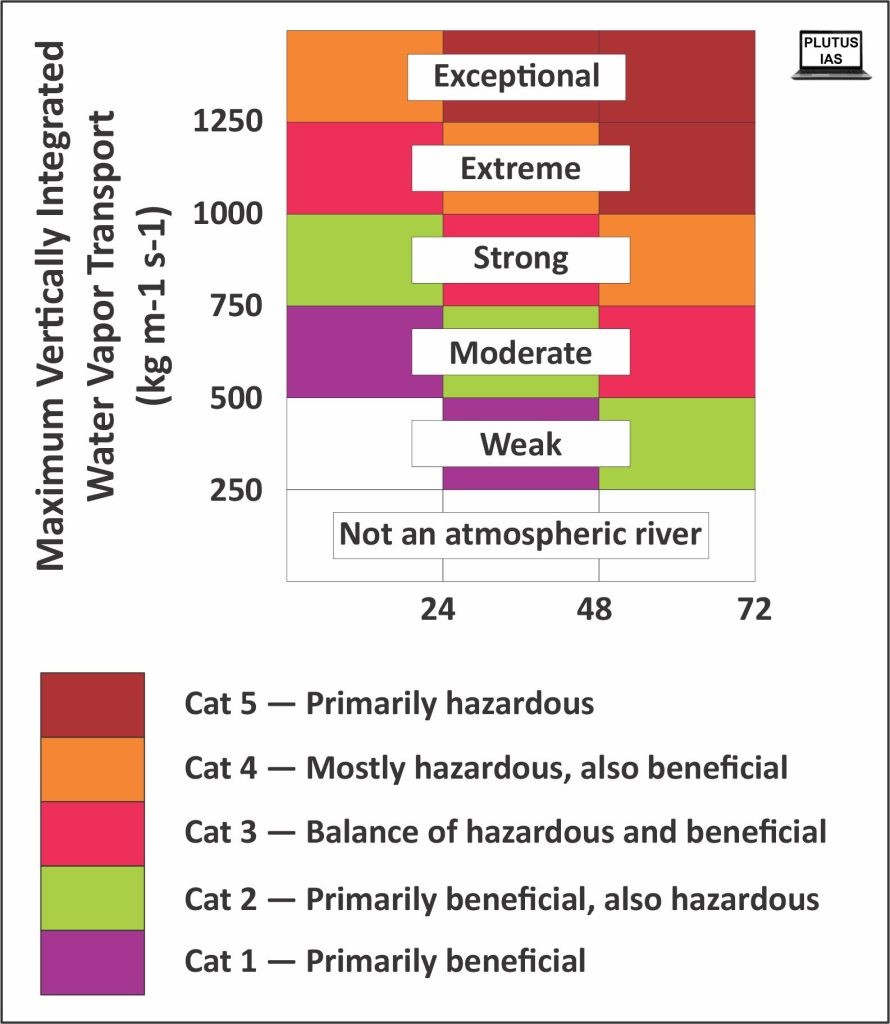13 Feb Atmospheric River
This article covers ‘Daily Current Affairs’ and the topic details of ”Atmospheric River”.This topic is relevant in the “Environment & Ecology section of the UPSC CSE exam.
Why in the News?
California, US, is currently dealing with an exceptional weather event known as an Atmospheric River, also known as the Pineapple Express Storm, which has the potential to dump up to 8 trillion gallons of rain in California.
What is an Atmospheric River?
- An atmospheric river is a plume of moisture, or water vapour, that flows from the tropics to deposit heavy rain or snow on a location. Atmospheric rivers are thin bands that form on the eastern side of powerful mid-latitude storms.
- On average, the Earth contains four to five active atmospheric rivers at any given time. Each transports a comparable amount of liquid water that flows past the mouth of the Amazon River. When this atmospheric river reaches land, it discharges moisture, resulting in severe snowfall and rain.
- The rain in California is part of a meteorological pattern known as the Pineapple Express, an atmospheric river that originates in the subtropical waters surrounding Hawaii.
- According to studies, atmospheric rivers endure about 20 hours along a coastline. A single atmospheric river can travel across the ocean for up to five days.
- Furthermore, an atmospheric river can cause a single region along the coast to be swamped with torrential rains for 12 to 72 hours.
Impact of El Niño on Atmospheric Rivers
- El Niño is a natural climate trend when warm ocean temperatures in the tropical Pacific cause heavy rainfall and storms. Every year, an average of seven to ten strong atmospheric rivers make landfall in California.
- El Niño years deliver greater moisture, increasing the frequency of atmospheric rivers along the West Coast of the United States. However, it is unclear if El Niño is solely responsible for increased precipitation and storm intensity.
Pineapple Express
- The “Pineapple Express” is a well-known example of an atmospheric river storm that dumps torrential rains on the US West Coast, particularly California.
- This name comes from the fact that these storms draw moisture from the tropical waters around the Hawaiian Islands, simulating an “express” train of moisture from Hawaii, which is sometimes connected with pineapples.
- This atmospheric river, powered by a strong southern branch of the polar jet stream, transports moist, warm mT air from as far away as the Hawaiian Islands.
Categories:
- Category 1 (Weak): In this category, an atmospheric river is a milder and shorter weather event that has largely favourable impacts, such as 24 hours of light rain.
- Category 2 (Moderate): A Category 2 atmospheric river is an ordinary storm that has largely positive impacts but is also potentially hazardous.
- Category 3 (Strong): A Category 3 atmospheric river is more strong and lasts longer, having both helpful and harmful effects. For example, a storm in this category could dump 5-10 inches of rain over 36 hours, replenishing reservoirs while also bringing some rivers close to flood stage.
- Category 4 (Extreme): A Category 4 atmospheric river is largely harmful, but it also has some advantages. A storm with this rating might produce enough heavy rain over several days to cause several rivers to flood.
- Category 5 (Exceptional): A Category 5 atmospheric river is mostly dangerous. An atmospheric river that lasted more than 100 hours over the Central California coast during the 1996-97 New Year’s holiday season. The severe rain and runoff caused more than $100 billion in damage.

The influence of atmospheric river
- The consequences of atmospheric rivers can be profound in the regions they impact. The intense precipitation associated with these phenomena can result in floods, landslides, and mudslides, causing damage to properties and, unfortunately, loss of life. Moreover, atmospheric rivers have the potential to disrupt water availability by overwhelming reservoirs and other water-related infrastructure. In specific instances, these weather systems can induce conditions resembling droughts by diverting moisture away from areas crucial for agriculture and other industries.
- However, it is crucial to recognize that not all atmospheric rivers lead to adverse effects. Many are mild systems that bring beneficial rain or snow, playing a vital role in maintaining water supplies. Some regions heavily depend on these systems for a substantial portion of their yearly precipitation. Appreciating the possible outcomes of atmospheric rivers is essential for readiness and effective management, considering these systems are integral components of the Earth’s water cycle.
Download plutus ias current affairs eng med 13th Feb 2024
Prelims practice questions
Q1) Consider the following statements:
1) The Troposphere layer is most directly affected by humidity
2) The atmospheric rivers in the context of drought-like conditions can exacerbate droughts
3) The winter season is typically associated with the highest frequency of atmospheric rivers in certain regions
How many of the above statements are correct?
- Only one
- Only two
- All three
- None
ANSWER: C
Mains practice questions
Q1) Explore the various weather phenomena associated with atmospheric rivers. How can these weather events impact local ecosystems, agriculture, and infrastructure?
Q2) Examine the challenges associated with predicting and forecasting atmospheric rivers. How do advances in meteorological technologies contribute to improved understanding and preparedness for these weather events?
I am a content developer and have done my Post Graduation in Political Science. I have given 2 UPSC mains, 1 IB ACIO interview and have cleared UGC NET JRF too.



No Comments